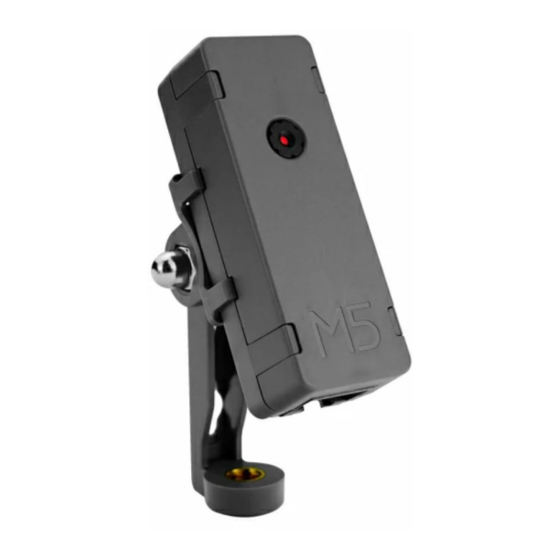
Table of Contents
Advertisement
Quick Links
Advertisement
Table of Contents

Subscribe to Our Youtube Channel
Summary of Contents for M5Stack POECAM
- Page 1 M5STACK- POECAM 2022 V0.01...
-
Page 2: Table Of Contents
TABLE OF CONTENTS OUTLINE ................3 2. SPECIFICATIONS ................. 4 3.FUNCTIONAL DESCRIPTION ............5 1.1..............5 AND MEMORY 1.2............... 5 TORAGE ESCRIPTION 1.2.1. External Flash and SRAM ..........5 1.3................5 RYSTAL 1.4......6 MANAGEMENT AND LOW POWER CONSUMPTION ELECTRICAL CHARACTERISTICS .......... -
Page 3: Outline
1. OUTLINE M5Station is a general-purpose IoT workstation in the M5Stack development kit series. It integrates rich interfaces and peripherals and is highly expandable. Large space reserved inside, flexible customization, and more likely to be applicable to various industrial acquisition and control application scenarios. -
Page 4: Specifications
2. SPECIFICATIONS... -
Page 5: 3.Functional Description
3.FUNCTIONAL DESCRIPTION This chapter describes the ESP32-D0WDQ6-V3 various modules and functions. 1.1. CPU AND MEMORY Xtensa®single-/dual-core32-bitLX6microprocessor(s), upto600MIPS (200MIPSforESP32-S0WD/ESP32-U4WDH, 400 MIPS for ESP32-D2WD): 448 KB ROM ⚫ 520 KB SRAM ⚫ 16 KB SRAM in RTC ⚫ QSPI supports multiple flash/SRAM chips ⚫... -
Page 6: Rtc Management And Low Power Consumption
1.4. RTC MANAGEMENT AND LOW POWER CONSUMPTION ESP32 uses advanced power management techniques may be switched between different power saving modes. (See Table 5). • Power saving mode - Active Mode: RF chip is operating. Chip may receive and transmit a sounding signal. -
Page 7: Electrical Characteristics
4. ELECTRICAL CHARACTERISTICS 4.1. LIMIT PARAMETERS Table 8: Limiting values 1. V IO to the power supply pad, Refer ESP32 Technical Specification Appendix IO_MUX, as SD_CLK of Power supply for VDD_SDIO. 4.2. WIFI RADIO FREQUENCY Table 9: Wi-Fi RF characteristics... -
Page 8: Low-Power Bluetooth Radio
4.3. LOW-POWER BLUETOOTH RADIO 4.3.1. receiver Table 10: Low-power Bluetooth receiver characteristics 4.3.2. launcher Table 11: Characteristics of Low Power Bluetooth transmitter... - Page 9 M5STACK- POECAM 2022 V0.01...
- Page 10 TABLE OF CONTENTS QUICK START ................3 1.1. ARDUINO IDE ..............3 1.2..............3 LUETOOTH SERIAL 1.3..............5 I SCANNING...
- Page 11 1.1. ARDUINO IDE Visit Arduino's official website(https://www.arduino.cc/en/Main/Software),Select the installation package for your own operating system to download. >1.Open up Arduino IDE, navigate to `File`->`Peferences`->`Settings` >2.Copy the following M5Stack Boards Manager url to `Additional Boards Manager URLs:` https://raw.githubusercontent.com/espressif/arduino-esp32/gh- pages/package_esp32_dev_index.json >3.Navigate to `Tools`->`Board:`->`Boards Manager...` >4.Search `ESP32` in the pop-up window, find it and click `Install`...
- Page 12 Open the Arduino IDE and open the example program `File`->`Examples`->`BluetoothSerial`->`SerialToSerialBT`. Connect the device to the computer and select the corresponding port to burn. After completion, the device will automatically run Bluetooth, and the device name is `ESP32test`. At this time, use the Bluetooth serial port sending tool on the PC to realize the transparent transmission of Bluetooth serial data.
- Page 13 BluetoothSerial SerialBT; void setup() { Serial.begin(115200); SerialBT.begin("ESP32test"); //Bluetooth device name Serial.println("The device started, now you can pair it with bluetoot h!"); void loop() { if (Serial.available()) { SerialBT.write(Serial.read()); if (SerialBT.available()) { Serial.write(SerialBT.read()); delay(20); 1.3. WIFI SCANNING Open the Arduino IDE and open the example program `File`->`Examples`->`WiFi`->`WiFiScan`.
- Page 14 #include "WiFi.h" void setup() Serial.begin(115200); // Set WiFi to station mode and disconnect from an AP if it was pre viously connected WiFi.mode(WIFI_STA); WiFi.disconnect(); delay(100); Serial.println("Setup done"); void loop() Serial.println("scan start"); // WiFi.scanNetworks will return the number of networks found WiFi.scanNetworks();...
- Page 15 This device complies with part 15 of the FCC Rules. Operation is subject to the following two conditions: (1) This device may not cause harmful interference, and (2) this device must accept any interference received, including interference that may cause undesired operation.
Need help?
Do you have a question about the POECAM and is the answer not in the manual?
Questions and answers